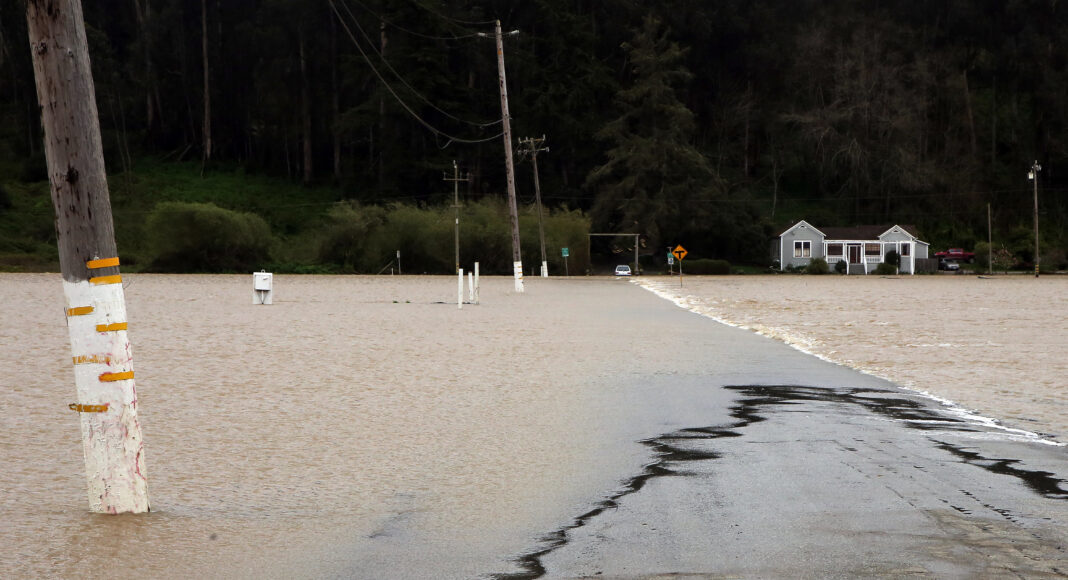Tears fill Marcelito Uribe’s eyes as he describes the night floodwaters from the Pajaro River inundated the car where he had been sleeping at Pajaro Rescue Mission and quickly rose above the windows.
Homeless, the 61-year-old had all his possessions in the car and a collection of tools he used for his one-person landscaping business. All of that, he says, is gone.
Uribe is staying in the Harvest Building at the Santa Cruz County Fairgrounds, one of 300 people using two buildings as temporary evacuation shelters.
When a friend walked up, shook his hand and asked him how he was doing, Uribe answered briefly in Spanish.
“Triste,” he says: “Sad.”
Uribe had no time to drive away when the water started rushing like a river at about 4am on Saturday. Instead, he climbed onto the car’s roof and called for help. He called 911, and the National Guard rescued him in a giant truck.
Inside the Fairgrounds buildings, dozens of cots line the concrete floors, each piled with blankets, pillows and frequently, people who would generally be working in the region’s now-submerged agriculture fields.
People sit quietly, chatting in small groups, as children recently bussed from school run laughing through the aisles. Two boys play soccer in one corner designated as a play space, four folding chairs their makeshift goals.
The Saturday storm caused a 100-foot section of the Pajaro River levee to break away, sending water roaring into the town of Pajaro and nearby residential areas and farm fields. That gap quickly eroded, widening to more than 300 feet before work crews sealed the gap on Wednesday.
Over 1,000 people were forced to evacuate as the water quickly inundated the town and surrounding agricultural fields.
Monterey County officials on Thursday opened an additional building at the Fairgrounds, expanding capacity there to 400. Shelters at Cabrillo College and the Watsonville Veterans Memorial Building were placed on standby.
Still, many residents say they cannot find a place to stay. Nearly two dozen people on waiting lists for shelter space must double up with friends or family, their cars or worse.
And with Monterey County Sheriff’s deputies guarding the closed-off Main Street bridge leading to Pajaro, where evacuation orders remain, residents are told it could be another week before they can return.
San Jose Mexican Consul General Alejandra Bolonga Zubikarai visited the Fairgrounds to talk to the Mexican nationals and let them know what services were available, including access to important paperwork and connecting them with services.
“We have the interest to see how our community is doing with this unfortunate situation and see if they have special needs,” she said. “I ensured them that we are here, and if they need to contact us, they can contact us.”
Part of the problem, she said, is the uncertainty facing the evacuees, who still have not been allowed to return to their storm-damaged homes. With fields still flooded, man workers are unsure whether they will still be able to plant this year.
“They don’t know if they will have work,” she says. “They don’t know what they are going to find when they go back to their home.”
A few miles away in Pajaro, Gov. Gavin Newsom walked on the levee to see the repairs completed Wednesday and said that more rain could be on the forecast.
“If anyone has any doubt about mother nature and her fury—if anyone has any doubt about what this is all about in terms of what’s happening to the climate and the changes that we’re experiencing, come to the state of California,” Newsom said.
Newsom added that farmworkers affected by the storm would soon receive $600 debit cards from a $42 million U.S. Department of Agriculture grant announced in October.
An official from Pajaro Valley Unified School District would hand out the cards at the Fairgrounds on Friday.
Newsom also questioned why permanent repairs to the levee had taken decades to make.
While those repairs will come within the next two years when the U.S. Army Corps of Engineers begins a $400 million upgrade to give 100-year flood protection, Newsom pointed out that the project will take 5-7 years.
“No one has patience for five to seven years,” he said, adding that the state should consider how it prioritized its projects in low-income communities.













